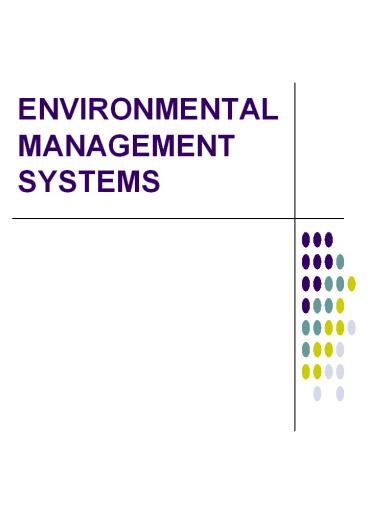ENVIRONMENTAL MANAGEMENT SYSTEMS - PowerPoint PPT Presentation
1 / 24
Title:
ENVIRONMENTAL MANAGEMENT SYSTEMS
Description:
ENVIRONMENTAL MANAGEMENT SYSTEMS ENVIRONMENTAL ISSUES Global Warming Climate Change Ozone Layer Resource Depletion Population Growth Waste Disposal Effects of ... – PowerPoint PPT presentation
Number of Views:193
Avg rating:3.0/5.0
Title: ENVIRONMENTAL MANAGEMENT SYSTEMS
1
ENVIRONMENTAL MANAGEMENT SYSTEMS
2
ENVIRONMENTAL ISSUES
- Global Warming
- Climate Change
- Ozone Layer
- Resource Depletion
- Population Growth
- Waste Disposal
- Effects of Pollution
3
BENEFITS OF AN EMS
- Better Image
- Cost Reductions
- Legislative Requirements
- Certification
4
ACCREDITATION STANDARDS
- ISO 14001 2004
- BS 8555 2003
- EMAS
- ISO 9001 2000
- OHSAS 18001 2007
5
ISO 14001 2004 SECTIONS
- 4.1 Scope of EMS
- 4.2 Environmental Policy
- - Documented
- - Commitments
- - Available to Public
6
4.3 PLANNING
- 4.3.1 Environmental Aspects
- 4.3.2 Legal Other Requirements
- 4.3.3 Objectives Targets
- 4.3.4 EMS Programme(s)
7
4.4 IMPLEMENTATION AND OPERATION
- 4.4.1 Resources, Roles, Responsibility
Authority - 4.4.2 Competence, Training Awareness
- 4.4.3 Communication
- 4.4.4 EMS Documentation
- 4.4.5 Document Control
- 4.4.6 Operational Control
- 4.4.7 Emergency Preparedness Response
8
4.5 CHECKING AND CORRECTIVE ACTION
- 4.5.1 Monitoring Measurement
- 4.5.2 Evaluation of Compliance
- 4.5.3 Non conformance and
- Corrective Preventive Action
- 4.5.4 Records
- 4.5.4 Internal Audit
9
4.6 MANAGEMENT REVIEW ANNEXES
- 4.6 Management Review
- Annex A Guidance
- Annex B Links with ISO 9001
- Annex C References
10
IMPLEMENTING ISO 14001 2004
- Initial Review
- Management commitment
- Aspects Identification
11
ENVIRONMENTAL ASPECTS
- Definition
- Element of an organisations activities, products
or services that can interact with the
environment.
12
ENVIRONMENTAL IMPACTS
- Definition
- Any change to environment whether adverse, or
beneficial, wholly or partially resulting from an
organisations activities, products or services.
13
ENVIRONMENTAL IMPACTS
- Raw materials, products, services, activities,
releases - Direct indirect effects
- Long or short term
- Adverse or beneficial
- Local, regional, global
- Bali Conference
14
IMPACT EVALUATION
- Identify all activities processes
- Identify EMS aspects
- Quantify if possible
- Gather data on releases
- Evaluate significance
15
ASPECT IDENTIFICATION
- Normal operations
- Cleaning maintenance
- Abnormal events
- Emergencies, incidents
- Potential hazards
- Past, present planned actions
16
DIRECT OR INDIRECT
- Waste from production
- Emissions
- Leakages
- Scrap product
- Transport (own fleet)
- Packaging
- Raw material sources
- Product use disposal
- Investments
- Energy usage
- Transport (external)
17
DECIDING SIGNIFICANCE
- Evaluate severity of effects
- Evaluate quantities
- Assess frequency
- Undertake a scoring exercise
- Record results
- Communicate results
- Repeat as necessary
18
MANAGEMENT RESPONSIBILITIES
- Set policies on waste prevention recycling
- Establish control systems
- Establish monitoring systems
- Set objectives targets
- Ensure EMS awareness
- Monitor performance
- Review encourage EMS improvements
19
CONTINUAL IMPROVEMENT
- Monitor objectives targets
- Monitor complaints, corrective preventive
actions - Improvement programmes
- Internal EMS audit
- Management review of EMS
20
EMERGENCY PLANNING
- Consider fire, flood, power loss, chemical
spillage, emissions, storms, earthquake,
insurrection transport accidents,explosions - Failure to control a significant aspect
- Plan for mitigation, recovery clean up
21
PREVENTIVE MEASURES
- Air emissions monitoring
- Water discharge monitoring
- Solid waste monitoring
- Waste reduction
- Energy reduction
22
REDUCED LIABILITIES
- Environmental hazard liabilities can be reduced
by action - Reduction in quantities types of hazardous
materials reduces risks - Emergency preparedness
23
LOCAL ISSUES
- Groundwater pollution
- Air emissions
- Visual impacts
- Land use or contamination
- Odour
- Noise
- Traffic
24
BUSINESS BENEFITS
- Image enhancement
- Community relations
- Acceptance of shareholders
- Friendlier pressure groups
- Better relations with legislators
- Better employee relations
- Reduced liabilities
- Cost savings go directly into profits































